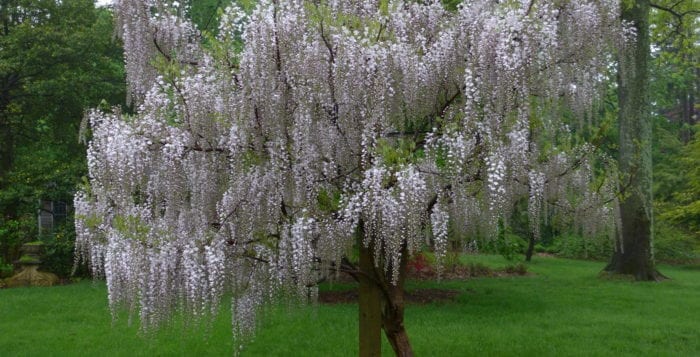By Kyrnan Harvey
Wisterias and lilacs are reliably in flower around the second Sunday in May on Long Island and, being 100 percent deerproof, make wonderful gifts for a mom who loves her garden.
They are long-lived and durable, which is certainly an understatement regarding wisteria. When I bought my house in East Setauket there was 20 or 30 years of unchecked growth between my house and a neighbor’s that was serving as a de facto privacy barrier: Oriental bittersweet, English ivy, Russian olive and natives poison ivy and greenbrier that were choking to near death a pair of American dogwoods and a few native spicebushes (Lindera benzoin). There was wisteria too, clambering all over the dead limbs of a fallen spruce.
My neighbor bemoaned the invasiveness of the wisteria, which was running along the ground, rooting in and climbing her Chinese dogwoods, an old beautybush (Kolkwitzia) and her giant old weeping cherry tree. I agreed that it is awfully invasive but that I would not remove it, valuing as I do the beauty and delightful scent of its flowers. I cut any vines that were not supported by the dead fallen spruce and initiated a war on the other nonnative invasives, preserving the dogwoods and clearing the way for my wife’s cut-flower/kitchen garden, and, yes, diminishing the privacy between our houses.
Yes, wisteria is horribly invasive, but sometimes it is worth leaving to climb into weed trees or over a chain-link fence, in which case you will want to be vigilant with the secateurs and folding pruning saw. If you have a pergola, the posts and beams of which are tall enough and strong enough, and you want a vine to grow over it, then wisteria is certainly at the top of the list of options. Consider well though the commitment of maintenance, which is to climb a ladder and cut-cut-cut the endless yards of rampant new growth all summer after flowering in May.
I have been planting wisterias since I started gardening 30 years ago. One of the first mistakes I made was buying a young (two- or three-year-old), unnamed, Chinese wisteria (Wisteria sinensis). I trained it to grow as a standard (tree form), but it was years before it flowered and, when it did, the flowers appeared simultaneously with the leaves, which partially obscured the flowers.
After 15 years of cut-cut-cut atop a step-ladder summer after summer, I asked Joe, my assistant, to cut it down. I couldn’t do it myself but I was ready with a superior replacement: a grafted tree form, Wisteria floribunda, ‘Shiro-noda’ (Snow Showers), in a 15-gallon container. For the next 10 years this was an absolute highlight of the gardening year, the very long fragrant white racemes appearing before the “tree” leafed out and with forget-me-nots and tulips below and a tree peony nearby.
If you want to buy a wisteria, seek a named cultivar of the Chinese (W. sinensis) or Japanese (W. floribunda) variety. Unless you want to grow it up a pergola, see if you can find one trained on a single trunk. It will always need support, as the physiology of the trunk is that of a vine, needing support to climb, and not that of a self-supporting tree. Grow it as a tree and curtail its growth. If you plant a grafted wisteria, you won’t have to wait years for it to start flowering. And I very much prefer varieties that flower before leafing out.
If wisteria sounds like too much of an undertaking and commitment, there is the option of a lilac (Syringa) for mother. These are nearly carefree, of equally delightful scent and the topic of my next gardening column.
Kyrnan Harvey is a horticulturist and garden designer residing in East Setauket. For more information, visit www.boskygarden.com.





